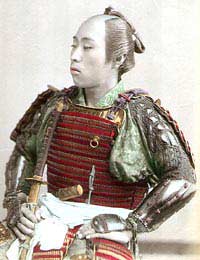Baldness and Warrior Traditions

Often men who are losing their hair feel that they are losing their youth. The suggestion that being bald proves you are more virile has been undermined by medical science and is not very reassuring. History, however, tells a different story. There are many different cultures worldwide where Baldness or the removal of part of the hair has traditionally been the mark of a warrior. Even some female warriors have chosen to remove their hair to demonstrate their warrior spirit.
The Aztecs
Aztec people used hairstyles in a very formal way to mark out different social roles. Warriors had a style called quachichictli, or 'shaven one', from which the very word for warrior derived. This involved shaving the hair at the sides of the head and leaving a narrow strip of tufty hair down the middle.This hairstyle was not just ornamental. In close combat, the portion of hair most easily grabbed by an enemy is that just above the ears. Shaving this could save a warrior's life.
The Cossacks
The Cossacks, a Slavic people who have lived on the Asiatic steppes for centuries, have a proud military tradition. Only a warrior with seven years' experience was allowed the honour of having a special military haircut, or 'chub'. The hair all over his head was shaved except for a single strand at the crown, which was worn as a ponytail. This meant that even men with receding hairlines could demonstrate their martial status.The Japanese
Samurai warriors wore their hair tightly pulled back into topknots. This could place stress on the hair at the front of the head and lead to an early receding hairline. This was not, however, considered a problem by the Samurai, for a very practical reason.One of the reasons for the success of the Samurai was their early adoption of high quality armour – including helmets. These helmets, however, could get very hot when warriors were exerting themselves during combat. It therefore became standard practice for warriors to shave the tops of their heads to make it easier to stay cool and achieve victory.
Native Americans
Several Native American tribes, including the Mohicans, Wyandot and Mohawks, chose distinctive hairstyle to represent their warrior status. Sometimes the mohawk cut would involve a high, spiked-up ridge of hair along the middle of the scalp, with the rest shaved bald. On other occasions, it would involve shaving everything except for a curl towards the front of the scalp.The Mongols
Like many other tribes, Mongol warriors shaved the hair on the sides of their heads, probably initially for safety reasons, though the style is still worn today by Mongolian soldiers who rarely participate in military action. Hair at the back of the head was tied up or braided so that warriors could show off its length without it getting in their way. This was particularly important because of their very windy environment, where long hair could mean not being able to see.Warrior Women
Over the past few centuries, European tradition has been marked by shaven-headed soldiers, less vulnerable to being grabbed and better able to wear helmets. The ritualised shaving of heads can also help soldiers to identify with the army to which they belonging, letting go of their old lives. New Masai warriors have their heads shaved for this reason, even though they grow their hair back later.As a result of this, shaving off the hair became a way for women who wanted to fight for a cause or to earn money to disguise themselves as men and enter European armies. The practice was also adopted by women like Joan of Arc who were open about their identities but wanted to stress that they were soldiers first. It has become increasingly popular among younger female soldiers in recent years, though no army currently requires it of them as many do of men.





